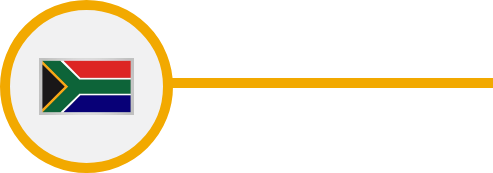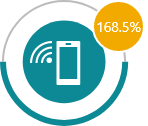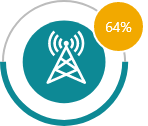BACKGROUND
According to WHO estimates, South Africa accounts for the eighth largest TB burden in the world (WHO Global TB report, 2021). In 2020, approximately 328,000 new cases emerged at an incidence rate of 554 for every 100,000 people, and 234,000 people are estimated to suffer from both TB and HIV [1]
With 6,784 individuals in the country developing drug resistant TB annually, and another 733 confirmed for XDR-TB, South Africa is a DR-TB high burden country. [1]
Overall, South Africa falls in all the 3 lists of 30 High Burden countries, i.e., high TB, DR-TB and TB/HIV case loads. [2]
South Africa has achieved a treatment coverage of 58% of all people living with TB in 2020 and the TB case fatality ratio stands at 19%. 51% of the children (aged < 5 years) that are household contacts of bacteriologically-confirmed TB cases have also been put on preventive treatment. [1]
Affected by the COVID19 pandemic, country’s TB case notification dropped in the second quarter of 2020, however, the health system is reviving its TB surveillance practices and the notification is steadily improving to reach 2019 levels
Through the National Strategic Plan (NSP) for HIV, TB, and sexually transmitted infections (STIs) 2017-2022, the Government of South Africa has committed to achieving the targets of United Nations General Assembly (UNGA) High-Level Meeting. The NSP has set direction for Acceleration of preventive efforts to reduce TB incidence; Reduction of morbidity and mortality through the provision of high-quality treatment care and support; Expanding target interventions to vulnerable communities; Increasing access while reducing stigma, justice and discrimination; Promoting sustainability through leadership and partnerships; Mobilization of domestic resources; and Strengthening strategic information systems. [3]
South Africa primarily uses TIER.Net as the tool for DS-TB notification, and the Electronic Drug Resistant Tuberculosis Register (EDRWeb) surveillance system for DR-TB reporting. Currently, out of the 4,300 TB health facilities, 3,000 have a direct access to enter case-based DS-TB data in the TIER.Net and 400 DR-TB facilities have access to EDRWeb. The remaining 1,300 facilities with infrastructural challenges submit manual reports to the sub-district or district level for data entry. The data is further imported in aggregate form to the Integrated WebDHIS (DHIS2) portal of MoH. Case based data for both DR- and DS-TB is submitted in DHIS2, however aggregate data integration does not include a lot of key variables from individual line lists (Migration, Patient transfers, etc), which currently restricts effective program monitoring.
The National Department of Health further envisions an integrated HIV-TB Electronic Health Record model, which would be integrated with the TB and HIV surveillance systems. Additionally, to complement the existing national HMIS, the TB data imported to DHIS2 is available as indicators for analysis with other data points, however, with the existing inconsistencies between systems, the related use for program management remains restricted.
It is empirical that technology penetration plays a vital role in enabling the evolution of information systems from paper to digital solutions. As per 2021 figures, about 168.5% of the population has a cell phone, and more than 91.2% use smartphones (2019). Internet penetration further stands at decent figures (i.e., 64%) in the country. It is thus a good opportunity to strengthen stakeholder coordination and leverage the friendliness of South Africa’s population with digital tools, which can set a strong ground to implement advanced digital solutions and ensure adequate uptake. [4] [5]
Based on the multi-stakeholder discussions, interviews and independent research, and guidance from the National TB Program, this assessment report is an attempt to describe the current capacity and identified gaps/ challenges in the digital ecosystem of TB surveillance. The report shares strategic recommendations for developing a comprehensive case-based surveillance system in the country while leveraging the existing infrastructure, in-house capacity, and assets.

STATUS OF CASE BASED TB NOTIFICATION
Currently the National TB program has been implementing primarily two tools for TB surveillance:
EDRWeb is the National TB program’s web-based tool for collection of case-based DR-TB records from the DR-TB facilities, and it is also integrated with an EDRWeb Dashboard for data visualization.
TIER.Net is the Health Information Systems Unit’s desktop tool for collection of case-based data for DS TB (and HIV) patients, which was developed as an extension of its predecessor, i.e., ETR.Net. Currently, the system is implemented across 3000 facilities and captures data of all TB patients put on treatment at the DS TB sites. With the complete ownership with HMIS unit and system deficiencies, there are challenges associated with use of TIER.Net.
The case-based data entered by the facilities (or districts, on behalf of some facilities without connectivity) is extracted in encrypted dispatch files, which are later used for importing to DHIS2 portal (called, Integrated WebDHIS) after conversion. The data received in DHIS2 is in Aggregate format and the reconciliation of dispatch files and data upload is yet not completely automated. Additionally, due to the lack of checks / validations, data can be duplicated too. This imported data is aggregated in the system and is disseminated upto the National level for program review and monitoring.
NTP further plans to use EDRWeb as the tool of choice for all TB reporting and will soon take up the incorporation of DS-TB notification and introduction of mobile apps for seamless data entry.
The development of EDRWeb is a notable example of a successful development of TB notification solution under NTP’s leadership. The platform is implemented and functional across all DR-TB sites and is working efficiently to cater to the related data needs for program management. Soon, the system is planned to be expanded for covering DS-TB reporting as well, which will establish it as the national tool for real time case-based TB notification, surveillance and data management.
As an innovation from the sub-country level, the Western Cape province of South Africa has developed a comprehensive and user-friendly public access dashboard (updated on a monthly basis) that aids in an effective data dissemination and also allows basic options and features to dive deeper into the presented data.

ELECTRONIC TB NOTIFICATION DATA COLLECTION AND USE
| TARGET | CURRENT SCALE | COLLECTION TOOLS | DATA TYPE | DATA USAGE | |||
|---|---|---|---|---|---|---|---|

National Level
|
Data Not Collected at this level
|
DHIS2 Dashboard EDRWeb dashboard |
|||||

District and
Metropolitan
Municipalities
|
52 | Data Not Collected from this level |
DHIS2 Dashboard
EDRWeb dashboard |
||||

Local
Municipalities
(sub-district)
|
280 | 280 | DHIS2 | Aggregate data (import of extracted data files) | DHIS2 Dashboard EDRWeb dashboard |
||

Facility level
|
4300 (1300 facilities send manual records to sub district level for data entry) | 3000 – DS TB reporting in TIER.Net, 400 – DR TB reporting in EDRWeb | TIER.Net (DS TB
facilities)
EDRWeb (DR TB facilities) Manual registers (all facilities) |
Case Based | EDRWeb dashboard | ||

Community Level
|
Data not collected at this level | No digital tool for data use | |||||

CASCADE OF CARE MONITORING
PRESUMPTIVE SCREENING
TB Testing
Treatment Initiation
Treatment Monitoring
Treatment Outcome
Contact Tracing






| KEY DATA VARIABLES | Yes/No |
|---|---|
| Demographic details (Age, DOB, Gender) |

|
| Address and contact details (Country, Division, District, House address) |

|
| Geolocation (GPS coordinates of the household) | |
| Contact details (Phone number/Mobile number, WhatsApp, Email etc.) |

|
| Health Facility address |

|
| Type of health facility (Public, Private etc.) |

|
| Site of TB (Pulmonary, Extra-pulmonary) |

|
| Type of diagnostic test (Microscopy, GeneXpert, TruNaat, CXR, etc.) |

|
| Date of test result |

|
| Drug susceptibility (DSTB, DRTB) |

|
| Treatment Regimen |

|
| Treatment start and end date |

|
| Co-morbidity (HIV, Diabetes, COVID-19 etc.) |

|
| Treatment monitoring/adherence |

|
| Treatment outcomes |

|
| KEY INDICATORS | Yes/No |
|---|---|
| Presumptive screening (proportion) | |
| Treatment initiation (proportion) |

|
| Treatment monitoring/adherence |

|
| Treatment outcome (proportion) |

|
| Spatial distribution of TB notification | |
| Age-group & sex wise aggregate numbers and proportions notified |

|
| Basis of diagnosis wise aggregate numbers and proportions notified |

|
| Type/site/drug resistance wise aggregate numbers and proportions notified |

|
| Provider source-wise aggregate numbers and proportions notified | |
| Comorbidity wise aggregate numbers and proportions notified | |
| Key-population wise aggregate numbers and proportions notified | |
| Estimate/Target wise notification/treatment coverage (proportions) | |
| Provider-type disaggregated treatment outcomes (proportions) | |
| Comorbidity disaggregated treatment outcomes (proportions) |

|
| Key population disaggregated treatment outcomes (proportions) |
 Digital
(aggregated)
Digital
(aggregated)
STATUS OF ELECTRONIC CASE BASED TB SURVEILLANCE
Electronic System For Case Based TB Notification

TIER.Net – DS TB EDRWeb – DR TB
Lowest Unit For TB Notification Digitisation
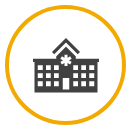
Facility level
Stage Of Notification

Treatment initiation
Level Of Access And Use Of TB Notification Data
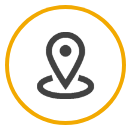
Facility level
Private Sector Notification
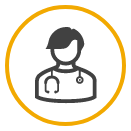
Manual notification process – Data submitted to sub district level for data entry
Frequency of digitization of TB notification

Daily - TIER.Net and EDRWeb Monthly - import to DHIS2
Mode Of Follow-Up With Notified Cases
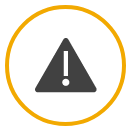
Manual follow-up- phone call, physical visit
Scale Of Implementation
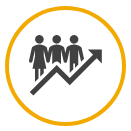
National roll out
Contact Tracing For TB Notified Cases
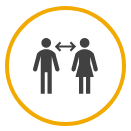
Done on manual registers and aggregate data (< 5 years child contacts) reported in DHIS2
Multi-Channel Enablement

Offline data entry in TIER.Net with the desktop application
Govt. order for mandatory TB notification

Yes
PRIVATE SECTOR NOTIFICATION

Private health providers submit their data to the sub-district level for data entry. Data is received as aggregate figures.
COUNTRY IT CAPACITY
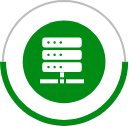
Country Server
TIER.Net system is hosted by the HMIS division of MoH, and EDRWeb is hosted by an outsourced private data centre.
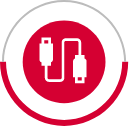
Interoperability
Data export functionality present for integration with other systems, which is being used for importing data to DHIS2.
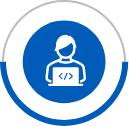
Country IT team
TIER.Net - developed by University of Cape Town and managed by HMIS/MoH EDRWeb - developed by WAM Technologies and managed by NTP
CURRENT RESOURCES AVAILABLE
USAID funding of USD 1 million is available with NTP for covering recurring costs, such as hosting and deployment, project management, technical support and internet costs.
The Global Fund has funded the development of TIER.Net and conduction of user trainings.
CDC has supported the development and initial training on EDRWeb, and now the funding support is being provided by USAID till 2024.

MILESTONES ACHIEVED AND ROAD MAP
2000
Development of ETR.Net (parent system of TIER.Net)
2005
ETR.net scale up across all districts in the country
2015
Development and pilot implementation of TIER.Net platform for DS-TB reporting
2010
Development and implementation of EDRWeb platform for DR-TB reporting
2021
Concurrent system strengthening and program review. Planning for integration of Lab systems
2017-19
Development of analytical Dashboards in WebDHIS (DHIS2) and EDRWeb system. Scale-up of TIR.Net implementation.
2022
Inclusion of DS TB in EDRWeb, integration of Lab systems, inclusion of TPT, Data Quality improvement, and introduction of mobile app with online/offline reporting
2023
Integrating patient notification functionality through SMS and Whatsapp, Stigma mitigation and CLM module addition. Introduction of modules for Digital adherence, Adverse event reports and Pharmacovigilance
2021
Integration of ITIS with PViMS, PMIS, GxAlerts and LIS/Data2Care. Enhancement and scale-up of End TB app suite implementation. Pilots and integration with Digital Adherence Tools (99DOTS, Pillboxes and VideoDOTS)

OTHER COMPLEMENTING DIGITAL TOOLS
| Purpose | Tools | Channel | Developed By | Supported By | Scale |
|---|---|---|---|---|---|
| Digital Adherence | Wisepill, PCAM | Pill boxes | Wise Pill | Stop TB Partnership | Pilot |
| Logistic Management System | Stock Visibility System | Web Application | Mezzanine | Ministry of Health | National |
| Laboratory Information Management | GxAlert | Web Application | Cepheid | National Health Laboratory Services | National |
| Digital X-Ray (CAD4TB) | Web Application | Qure.AI | The Global Fund | Pilot | |
| Community Led Monitoring (for contact tracing) | SMS to patients (Ritshitze) | SMS | Ritshitde | PEPFAR | Pilot |
| Contact Tracing | Nil | NA | NA | NA | NA |

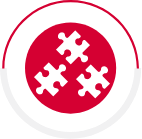

KEY CHALLENGES

Shortage of personnel and lack of training, results in an acute crunch of trained manpower at the data entry points.

Availability of desktops and laptops for data entry at 1300 facilities is inadequate for direct data reporting, and as a result of this, data is entered from sub-district level, which causes delays and data quality concerns.

Inconsistency with electricity and internet connectivity, along with an inadequate hardware maintenance causes challenges in real time data reporting.

TIER.Net system (DS TB) is an offline desktop application and as a result, however the data is entered on a daily basis (varies across facilities), its compilation and data access for stakeholders is challenging.

It being a shared system with other programs, NTP does not have an ownership on TIER.Net, which causes major dependency on the HMIS team for smallest of changes and configurations.

Without 100% transition to real-time case-based reporting and automatic integration with tools like DHIS2 and GeneXpert (and other NHLS tools), major gaps will remain around access to real time data, its analysis and use for action by the stakeholders.
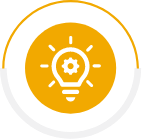
NTP VISION
- ❖ System enhancement to capture data for screening and Lab services in real time, to improve drop-outs and reducing the loss to follow up.
- ❖ Inclusion of migrant care in the region for improving patient coverage and continuity for treatment.
- ❖ Development of an advanced program monitoring dashboard, to enhancing data quality, enabling tracking of cross border patient movement, improving visualization of patient trends and identifying bottlenecks at facilities.
- ❖ Improving EDRWeb’s interoperability with other systems.
- ❖ Technical assistance and support for betterment in IT infrastructure at facilities, Human resource training, and concurrent capacity building.
- ❖ Introduction of a mobile app for strengthening data entry from all TB facilities.

RESOURCES NEED
Based on multi-stakeholder discussions, country feedbacks and recommendations for full-filling country’s vision, we have put together an estimated investment requirements and areas needing support for provisioning of a comprehensive case based digital TB surveillance system
Hardware and Infrastructure :

Mobile Devices (for data collection)::: South Africa has 4300 TB facilities and to provision mobile device for every facility for case-based TB surveillance, USD 645,000 will be needed assuming USD 150 per mobile devices. If needed, additional budget can be booked for community settings.

Tablet (for data use): : South Africa has 280 sub-districts, 52 districts and 9 provinces, and to promote active data use, each sub-district, district and province should be given a tablet which would cost roughly around USD 68,200 assuming USD 200 per Tablet devices.

Internet: In case WiFi is not available in each facility, then mobile internet cost of around USD 1,290,000 should be considered (assuming USD 100 mobile data cost for the entire year per facility, district and regional user).

Server: Based on the current volumes of new cases, South Africa would need an investment of USD 20,000-30,000 for next 3 years for server and server maintenance.
Note: Existing devices available through other health programs can be leveraged. In that case, the above-mentioned costing can be accordingly considered.
Software Development :

Based on various multi-stakeholder meetings and given the fact South Africa already have a strong foundation for case-based reporting of TB, around USD 250,000-400,000 should be budgeted for a comprehensive TB surveillance system and analytical dashboard for data use.
Capacity Building and Implementation :

After the software development, a dedicated pool of technical resources will be needed to support platform administration, data management and support. A team of 4-6 skilled resources attributing to a cost of around USD 48,000-72,000 per annum should be budgeted (or USD 144,000-216,000 for 3 years assuming USD 1,000 per month per resources). Additionally, reskilling of the current IT team should be budgeted.

Training: This would involve training material development and onsite and remote training of the trainers. Training sessions should be planned for each of the 280 sub-districts, which could cost roughly USD 100 per sub-district, amounting to USD 84,000 which will be further supported with e-Learning packages.
TOTAL investment of around USD 2.5 – 3.0 million for 3 years will be needed for further strengthening and maintaining a comprehensive case-based digital TB surveillance system for South Africa.
Disclaimer: The above budget is a function of number of facilities, districts and regions and expected volume of data. This only provides a ballpark figure of what is needed in terms of budget.

Recommendations
Following are some of the key recommendations suggested based on the findings of this assessment of country’s digital ecosystem and infrastructure:

Strategic Costing Plan
As a first step it is important for the country to create a comprehensive costed action plan for development, implementation and scale up of the TB case-based surveillance system.
Based on NTPs vision and the recommendations for improvements , the plan should clearly define targets with actionable interventions and funding requirements supported with a detailed work plan with timelines. The plan will help the country to assess and monitor the progress and to mitigate risks
Tentative timeline: Month 0-1

Establishing EDRWeb as the core Case Based TB surveillance system
The NTP has already established a strong case-based reporting environment through the TIER.Net and EDRWeb platforms, which forms the core infrastructure in terms of database and deployment environment. It has built the expertise and capacity for executing the vision of implementing a comprehensive and integrated real-time case-based TB surveillance and notification system.
While the current EDRWeb case-based system development is covering only a section of the TB care continuum, the application should be further expanded to include a comprehensive monitoring for both DR and DS TB through a single system, including presumptive screening, referral, cross border migration and contact tracing in real-time.
The solution architecture should support adding all the above components in phases supported with versioning to ensure seamless upgrades and continuity.
Tentative timeline: Month 0-12

Technical and Functional review
of TIER.Net
A key challenge highlighted by NTP is the restricted environment offered by TIER.Net and its ineffective use due to system deficiencies.
A thorough technical and functional review of the TIER.Net platform is crucial to understand these inconsistencies and gather learnings to refine the existing as well as future solutions.
Tentative timeline: Month 0-12

Device Procurement
One of the limitation highlighted by NTP is the need to improve the data collection processes at the facility and community level. To streamline this, procurement, distribution and maintenance of the required data entry equipment like laptops, mobile/tablet devices should be done on an urgent basis. Improving the current infrastructure at the facilities is crucial for a complete transition to digital notification from the site of service delivery.
Tentative timeline: Month 0-6

System Integration
One of the challenges highlighted by NTP is the leveraging the data collected from the multiple sources into the main DHIS2 systems as a central system for effective use.
The current EDRWeb / TIER.Net system infrastructure needs to be extended to support bi-directional integration and interoperability with external systems like National EHR, NHLS, GeneXpert, TruNat, Digital X-Ray outputs, Pill boxes and other adherence tools which help in using the data effectively for the patient continuum of care as highlighted by the National program.
Recommended exchange / ETL tools like Talend and Informatica can make the data management task much easier and simultaneously improve data warehousing. [6.1] , [6.2]
With data export functionalities, the platform architecture of EDRWeb is compatible with these standard tools and processes making this an effective solution. [7.1] , [7.2]
The data exchange process should follow and comply with FHIR , GDPR standards for more secured and seamless data exchange.
Tentative timeline: Month 0-6

Mobile App
Implementation of data collection via mobile app to ensure ease of use and real time reporting to the national database.
One of the challenges reported by the NTP is inconsistent data connectivity, network issues and system restrictions that delay reporting of cases, and an inconsistent availability of hardware for data entry. One effective way to overcome this is to support the current data collection processes by introducing a mobile application for the government facilities.
Other advantages for a mobile application include better performance, effective use of device features like in house system updates , usage of GPS, security measures and tracking user patterns and issue log mechanisms and other analytics measures.
Several mobile solutions for real-time case-based notification can be explored for local adaption and building the mobile counterpart for eTB manager. Open-source technologies like ODK and KOBO are some notable examples. [8]
Tentative timeline: Month 0-12

E-Learning
To address the challenges with periodic training of facility level staff to orient them on using TIER.Net and EDRWeb for real time data reporting, the MoH must engage in development of an eLearning module for application training.
While some software offer standard training modules on the application, training tools like Moodle [9] built on standard Learning Management System ( LMS ) framework should be reviewed for application rollouts.
Additionally, for training and updates on the latest manual of procedure and continued medical education on TB care, modules can be developed for TB Health providers, administrators at facility and district level to develop and enhance M&E competencies for ensuring a consistent program oversight, specially for the case-based tracker roll out within the existing applications.
Guide TB platform developed by WHO Philippines is a good example of eLearning module for health staffs involved in TB care.
Tentative timeline: Month 0-3

Capacity building for application maintenance
Planning for capacity building includes workforce assessment, ranging from ICT professionals to health workers providing care services. Since the application requires regular updates and adaptations, the system support team requires trained personnel on the technology stack in use.
Strengthening the NTP team with trained system administrators will help in reducing costs (in seeking technical support) and improving and expediting the planned implementations.
Tentative timeline: Month 6-24

Contact tracing application implementation
To strengthen the TB surveillance efforts of the country and for reaching out to all TB positive individuals, an active focus on contact tracing becomes crucial. The standard guidelines for household screening can be incorporated as a module in the national TB notification tool and be implemented to fast track the country’s efforts to eliminate TB and target the initiation of preventive treatment for all TB contacts.
Tentative timeline: Month 6-12

Patient Interactive Systems for ensuring retention on TB treatment
Establishing a direct and secured mechanism for engaging with patient has potential for drastic improvements in tracking lost to follow-up patients.
Expanding the already running pilots of Community Monitoring tools in the country, to leverage features like auto generation of notification and messaging by the system through communication channels like Social Media channel, IVRS and SMS outbound messages, should be considered. Existing solutions like the SMS notifications to patients for lab results can be further scaled, and Open-source applications like Open MRS can also be used for these activities. [10]
Tentative timeline: Month 6-24

Community Monitoring Systems
As expressed by the NTP, the national TB notification and surveillance system should explore ready-to-use open source CLM platforms like One Impact. One Impact, where they can connect with their peers, community and authorities to report issues like stigma and their reservations towards adhering with prescribed drugs.
Tentative timeline: Month 6-12

Data Use
The NTP’s plan clearly emphasizes on the importance and need for improve data use. This can be made possible by making case-based TB data and required linelistings available across systems in a more real time fashion.
Building on the current EDRWeb and DHIS2 visualization modules that offer a dashboard for reviewing program and data indicators, additional features of pivot table , event reports which support dimensions, data aggregation reports, individual line lists and job aids are extremely useful.
Apart from the standard DHIS2 and EDRWeb dashboard features (and to strengthen and expand the data visualisation scope and making effective use of data for predictive modelling, data science and for advanced analytics) it is recommended to use best of the breed tools like Tableau, Power BI (well compatible with the open-source technologies, like DHIS2) which offer these features. APIs can be generated and connected with these applications, and these can be used as an extended analytical component of the data analysis framework. [11]
Tentative timeline: Month 6-12

Data Quality
As part of the standard practice, the application(s) / solutions should follow a set of standard data quality mechanisms or the Data Quality Assurance (DQA) framework which would help in improved data credibility and use.
UIC Code: Having a centralized Unique Patient ID system or leveraging existing national ID supported with an improved search functionality can help drastically reduce the duplication of case-based records.
This should be generated automatically through the case-based TB surveillance system that is already implemented.
Data access control is another such DQA measure that will regulate user’s access to only relevant metadata. It will involve the principle of least privilege (POLP), i.e., user’s access will be determined based on their role in the project. POLP will define and limit what data they have access to and who has that access.
Tentative timeline: Month 6-18

Strategic Technical Recommendations
Application Upgrades including Server Augmentation & Infrastructure Upgrades : To make sure that systems implementation and scale up of application is supported well, the key need is to have a long-term strategic plan that would cover the technical and operational objectives.
The strategy recommended would cover the following core areas
✓ Technical Upgrades: Based on the architecture, the upgrade would be done with the database, a middleware system, the operating system or the hardware.
Additionally, the architecture should support the integration layer which would be needed for data exchange with other national / external systems. The technologies that need to be brought in and the areas of inter-connection need special focus.
Recommended data system architecture would include updating the version of the current DHIS2 to 2.34 which offers better features on data management , encryption and exchange standards.
Additionally, the advance admin features offered by this version help the administrators to support the operational needs better for onboarding users , real time change in data variables and user management etc effectively.
Apart from this version 2.34 also supports compliance to GDPR standards and offers more controlled data encryption practises. [12]
✓ Performance Optimisation & Testing : To support the national scale up and implementation strategies it is very essential to have system(s) and application testing done to enable a reliable platform and which also helps in architecture updates and augmentation.
Automated System and Application Testing tools like Selenium and Appium can be used. Load Testing tools which helping in database sizing and planning need to be adapted for effective planning . [13]
✓ Application & System Security Audit
To strengthen the current systems framework and ensuring long term sustenance it is important to have regular evaluation of the security of the information and systems by measuring how well it conforms to an established set of criteria.
These would also include developing a framework which should outline policies in line with recommended standard policies like HIPAA [14.1], [14.2] to cover
• Patient Data Management
• Server & Infra guidelines
Apart from application measures offered by offered by DHIS2 [15] for patient data security , hosting solutions offered from Azure also cover these as part of their deployment options which can be considered as part of systems hosting. [16]
ACKNOWLEDGMENT
We thank the National Program Manager, Dr Lindiwe Mvusi and the entire team for participating and engaging in the assessment. We would also like to extend our gratitude to Dr. Sicelo Dlamini for providing valuable insights into South Africa’s vision for creating an advanced case-based TB surveillance and notification system.
CONTACT DETAILS
National Tuberculosis and HIV
Program
Department of Health
Dr AB Xuma Building, 1112 Voortrekker Rd,
Pretoria Townlands 351-JR, PRETORIA, 0187,
South Africa
Telephone : 012 395 8000
Email : Lindiwe.Mvusi@health.gov.za
REFERENCES
- TB Data References : https://worldhealthorg.shinyapps.io/tb_profiles/?_inputs_&entity_type=%22country%22&lan=%22EN%22&iso2=%22BD%22.
- TB Data References : http://www.stoptb.org/countries/tbdata.asp.
- TB Data Reference : https://www.usaid.gov/sites/default/files/documents/South_Africa_TBRM21_TB_DIAH_Version_Final.pdf.
- Digital Landscape : https://datareportal.com/reports/digital-2021-southafrica?rq=southafrica
- Digital Landscape : https://www.itweb.co.za/content/xA9PO7NZRad7o4J8
- System Integration Tools ( Talend , Informatica ) : https://www.talend.com/index.php, https://www.informatica.com/
- DHIS 2 API & DHIS2 Data Transformation Services : https://docs.dhis2.org/en/develop/using-the-api/dhis-core-version-235/web-api.html, https://docs.dhis2.org/en/use/user-guides/dhis-core-version-236/maintaining-the-system/importexport-app.html
- DHIS2 Mobile App : https://dhis2.org/android/
- Application Training Tool : https://moodle.org/
- OPEN MRS : https://openmrs.org/
- DHIS2 Power BI : https://community.dhis2.org/t/dhis2-to-powerbi-connector-is-ready-check-out-the-video-test-it-use-it-and-give-us-feedback/37043
- Features of DHIS 2.34 : https://dhis2.org/overview/version-234/
- Performance Tools ( Selenium , Appium ) : https://appium.io/, https://www.selenium.dev/
- HIPAA Compliance Framework : https://www.hhs.gov/hipaa/for-professionals/security/laws-regulations/index.html, https://www.hipaajournal.com/considered-phi-hipaa/
- DHIS Security : https://dhis2.org/security/
- Azure Hosting Services : https://docs.microsoft.com/en-us/azure/compliance/offerings/offering-hipaa-us
